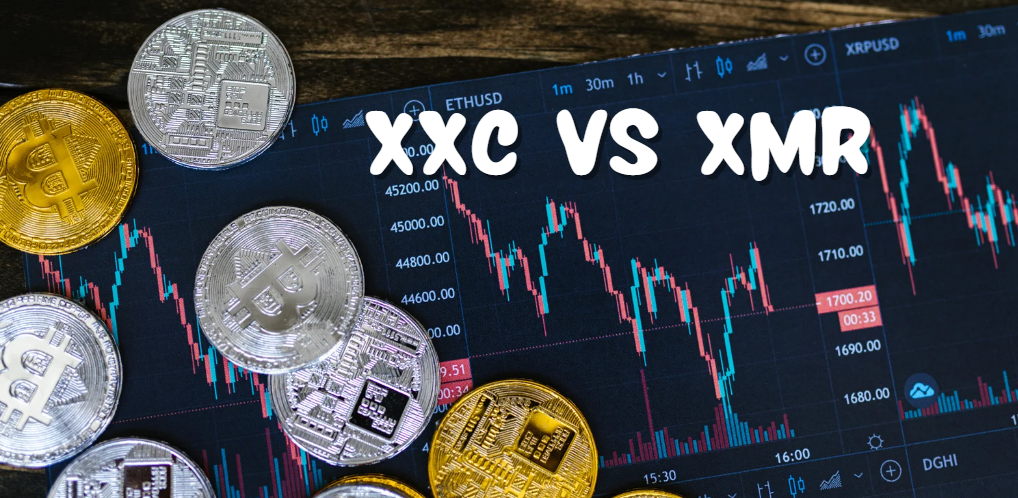In the world of cryptocurrencies, various coins have emerged, each with its unique features, use cases, and technological foundations. Two such coins are XXC (X-Coin) and XMR (Monero).
This article delves deep into the comparison between XXC and XMR, examining their origins, technological differences, privacy features, use cases, market performance, and future potential. Our goal is to provide a detailed analysis that not only summarizes existing information but also offers unique insights and interpretations. This comprehensive guide aims to be the ultimate resource on “XXC vs XMR.”
Understanding XXC and XMR
What is XXC?
XXC, or X-Coin, is a relatively new entrant in the cryptocurrency market. Designed with an emphasis on privacy, speed, and decentralization, XXC aims to provide users with a secure and efficient digital currency for everyday transactions. Its development team has focused on incorporating cutting-edge cryptographic techniques to ensure transaction anonymity and data protection.
What is XMR?
Monero (XMR) is one of the most well-known privacy-focused cryptocurrencies. Launched in April 2014, Monero has built a strong reputation for its robust privacy features, which make transactions untraceable and unlinkable. It uses a public ledger to record transactions, but details such as the sender, receiver, and transaction amount are obscured using advanced cryptographic techniques.
Technological Foundations
XXC’s Technology
XXC is built on a unique blockchain architecture designed to optimize both privacy and speed. Key technological aspects include:
- Zero-Knowledge Proofs (ZKPs): XXC utilizes ZKPs to enable secure transactions without revealing transaction details.
- Ring Signatures: Similar to XMR, XXC employs ring signatures to obscure the sender’s identity.
- Stealth Addresses: These ensure that the recipient’s address is hidden, providing another layer of privacy.
- Fast Block Times: XXC boasts rapid block times, which contribute to quicker transaction confirmations.
XMR’s Technology
Monero’s technological foundation is robust, focusing heavily on privacy and decentralization. Key components include:
- Ring Signatures: Used to mix the sender’s output with others, making it difficult to trace the transaction back to the sender.
- Ring Confidential Transactions (RingCT): This feature hides the transaction amount, adding an extra layer of privacy.
- Stealth Addresses: These allow the recipient to receive funds without their address being linked to the transaction.
- Bulletproofs: An upgrade to RingCT, Bulletproofs significantly reduce the size of confidential transactions, improving efficiency and reducing fees.
Privacy Features
Privacy in XXC
XXC prioritizes user privacy through a combination of advanced cryptographic techniques:
- Anonymity: By using ring signatures and stealth addresses, XXC ensures that both the sender and receiver remain anonymous.
- Untraceability: Transactions are designed to be untraceable, meaning it is challenging to link them to any particular user.
- Decentralization: XXC’s decentralized network ensures that there is no central authority that could potentially compromise user privacy.
Privacy in XMR
Monero is renowned for its strong privacy features, which include:
- Unlinkability: Monero transactions are unlinkable, meaning it is not possible to determine whether two transactions were sent to the same recipient.
- Untraceability: Using ring signatures and stealth addresses, Monero transactions are untraceable, ensuring that transaction history cannot be reconstructed.
- Optional Privacy: While privacy is the default, users have the option to share view keys with third parties if they choose to do so.
Use Cases
Use Cases for XXC
XXC is designed to be a versatile digital currency with several potential use cases:
- Everyday Transactions: With its fast transaction speeds and low fees, XXC is ideal for everyday purchases and peer-to-peer payments.
- E-commerce: Merchants can accept XXC as a payment method, providing customers with a private and secure payment option.
- Remittances: XXC can be used for cross-border remittances, offering a fast and cost-effective alternative to traditional methods.
Use Cases for XMR
Monero’s primary use cases revolve around its strong privacy features:
- Private Transactions: Individuals who prioritize privacy can use XMR for transactions without revealing their identity or transaction details.
- Investment: As a well-established cryptocurrency, XMR can be used as an investment asset within a diversified portfolio.
- Darknet Markets: Due to its privacy features, XMR is often used in darknet markets, although this association also brings regulatory scrutiny.
Market Performance
XXC’s Market Performance
As a newer cryptocurrency, XXC’s market performance is still developing. Factors influencing its performance include:
- Adoption Rate: The rate at which users and merchants adopt XXC will significantly impact its market value.
- Technological Advancements: Continued innovation and improvement in XXC’s technology can drive market confidence and value.
- Regulatory Environment: Changes in cryptocurrency regulations can affect XXC’s market performance, both positively and negatively.
XMR’s Market Performance
Monero has established itself as a leading privacy coin, with a strong market presence. Key factors in its market performance include:
- Market Capitalization: XMR consistently ranks among the top cryptocurrencies by market cap, reflecting its widespread adoption and investor confidence.
- Price Volatility: Like most cryptocurrencies, XMR experiences significant price volatility, influenced by market sentiment, technological developments, and regulatory news.
- Community Support: Monero has a strong and active community that supports its development and adoption, contributing to its market resilience.
Security Considerations
Security in XXC
XXC employs various measures to ensure the security of its network and transactions:
- Cryptographic Security: The use of advanced cryptographic techniques ensures that transactions are secure and private.
- Decentralization: A decentralized network architecture reduces the risk of central points of failure or attacks.
- Continuous Audits: Regular security audits and updates help identify and mitigate potential vulnerabilities.
Security in XMR
Monero’s security features are well-regarded within the cryptocurrency community:
- Secure Transactions: The use of ring signatures, RingCT, and stealth addresses ensures that transactions are secure and private.
- Decentralization: Monero’s decentralized network enhances its security by reducing the risk of attacks.
- Community Vigilance: The active Monero community contributes to its security by identifying and addressing potential threats.
Future Potential
The Future of XXC
The future potential of XXC depends on several factors:
- Adoption and Integration: Increased adoption by users and merchants will drive XXC’s growth and market value.
- Technological Innovation: Continued advancements in XXC’s technology will enhance its competitiveness and appeal.
- Regulatory Developments: Navigating the evolving regulatory landscape will be crucial for XXC’s long-term success.
The Future of XMR
Monero’s future potential remains strong, driven by its established position and ongoing development:
- Privacy Enhancements: Continued improvements to Monero’s privacy features will strengthen its appeal to privacy-conscious users.
- Broader Adoption: As privacy concerns grow, Monero may see increased adoption in various sectors.
- Regulatory Challenges: Monero will need to navigate potential regulatory challenges to maintain its position in the market.
Comparing XXC vs XMR: Key Differences
Privacy
- XXC: Emphasizes transaction anonymity through ZKPs, ring signatures, and stealth addresses.
- XMR: Focuses on untraceable and unlinkable transactions using ring signatures, RingCT, and stealth addresses.
Speed and Scalability
- XXC: Designed for fast transactions with low fees, making it suitable for everyday use.
- XMR: While privacy features can impact transaction speed, Monero is continually improving scalability and efficiency.
Adoption and Community
- XXC: As a newer coin, XXC’s adoption and community support are still growing.
- XMR: Boasts a strong and active community with widespread adoption and market presence.
Market Perception
- XXC: Viewed as an innovative newcomer with potential for growth.
- XMR: Established as a leading privacy coin with a strong market reputation.
Unique Insights and Interpretations
While both XXC and XMR offer robust privacy features, they cater to slightly different niches within the cryptocurrency market. XXC, with its focus on speed and usability, positions itself as a practical digital currency for everyday transactions. Its innovative use of ZKPs and other cryptographic techniques highlights its commitment to privacy without compromising efficiency.
On the other hand, Monero remains the gold standard for privacy in the cryptocurrency world. Its continuous development and active community support ensure that it stays ahead in terms of privacy features. Monero’s resilience in the face of regulatory scrutiny also underscores its robustness and the community’s commitment to maintaining privacy.
In terms of future potential, both coins have promising prospects. XXC’s growth will largely depend on its ability to attract users and integrate with various platforms. Its technological advancements will play a crucial role in this regard. Monero, meanwhile, will likely continue to lead the privacy coin market, especially as privacy concerns become more prominent in the digital age.
Frequently Asked Questions (FAQs)
1. What are the main differences between XXC and XMR?
XXC and XMR both prioritize privacy, but XXC focuses on transaction speed and usability, while XMR is renowned for its robust privacy features and strong community support. XXC uses zero-knowledge proofs and has faster block times, whereas XMR employs ring signatures, RingCT, and Bulletproofs for privacy.
2. Which coin is better for everyday transactions?
XXC is designed with fast transaction speeds and low fees, making it more suitable for everyday transactions compared to XMR. However, XMR can also be used for daily transactions if privacy is a top priority.
3. How do XXC and XMR ensure transaction privacy?
XXC uses zero-knowledge proofs, ring signatures, and stealth addresses to ensure transaction privacy. XMR employs ring signatures, RingCT, and stealth addresses to make transactions untraceable and unlinkable.
4. What are the potential risks associated with using XXC and XMR?
Both XXC and XMR face potential risks such as regulatory scrutiny and market volatility. Additionally, as privacy coins, they may be subject to bans or restrictions in certain jurisdictions.
5. How do I choose between XXC and XMR?
Choosing between XXC and XMR depends on your specific needs. If you prioritize fast and cost-effective transactions, XXC may be the better choice. If robust privacy is your primary concern, XMR is likely the better option.
Conclusion
In the comparison of “XXC vs XMR,” both cryptocurrencies stand out for their strong privacy features and technological innovations. XXC, as a newer entrant, offers promising features with its focus on speed and usability, while XMR remains a leader in the privacy coin market with its robust and proven privacy mechanisms.
Ultimately, the choice between XXC and XMR will depend on individual preferences and use cases, with XXC appealing to those seeking fast and efficient transactions and XMR catering to privacy-conscious users. As the cryptocurrency landscape continues to evolve, both XXC and XMR are poised to play significant roles in the future of digital finance.

















